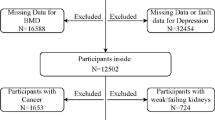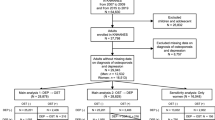Abstract
Previous epidemiological study has suggested that depression might be associated with low bone mass in Caucasian women. This has not been studied in Asian men. Mr. Os (Hong Kong) is the first, large, cohort study on osteoporosis in Asian men, and the current analysis deals with the association between depression and bone mass in this group. Data from the baseline examination of Mr. Os (Hong Kong) were used. Two thousand Hong Kong men aged 65 to 92 years were recruited from the community. Depression was diagnosed by face-to-face interview, using a validated Chinese version of the Geriatric Depression Scale (GDS), with depression being defined as a cut-off score of 8 or more. Bone mineral density (BMD) of the lumbar spine, total hip and total body was measured by dual X-ray densitometry (DEXA) using the Hologic QDR-4500 W densitometer. Multiple regression was used to compare BMD in depressed and non-depressed subjects, controlling for confounding variables. In the study sample 8.5% of men were found to be depressed, and the BMD at the total hip in these subjects was 2.1% lower than in non-depressed subjects (95% CI −0.13 to −4.1), after adjustment for age, body weight, medical history, alcohol consumption, cigarette smoking, calcium intake, physical activity and antidepressant use. Depression was associated with a 1.4-fold (95% CI 1.00 to 2.08) relative risk (RR) of being diagnosed with a T-score equal to or less than −1.0 (low bone mass). We conclude that depression is associated with lower BMD; however, to determine whether depression causes lower BMD or vice versa, we will need to await findings from future prospective studies.
Similar content being viewed by others
References
Woo J, Ho SC, Lau J, Yuen YK, Chiu H, Lee HC, Chi I (1994) The prevalence of depressive symptoms and predisposing factors in an elderly Chinese population. Acta Psychiatr Scand 89:8–13
Whooley MA, Simon GE (2000) Primary care: Managing depression in medical outpatients. N Eng J Med 343:1942–1950
World Health Organization (2001) The world health report 2001—mental health: new understanding, new hope. World Health Organization, Geneva
Tinetti ME, Williams TF, Mayewski R (1986) Fall risk index for elderly patients based on number of chronic disabilities. Am J Med 80:429–434
Nevitt MC, Cummings SR, Kidd S, Black D (1989) Risk factors for recurrent nonsyncopal falls: a prospective study. JAMA 261:2663–2668
Michelson D, Stratakis C, Hill L, Reynolds J, Galliven E, Chrousos G, Gold P (1996) Bone mineral density in women with depression. N Eng J Med 335:1176–1181
Schweiger U, Weber B, Deuschle M, Heuser I (2000) Lumbar bone mineral density in patients with major depression: evidence of increased bone loss at follow-up. Am J Psychiatry 157:118–120
Robbins J, Hirsch C, Whitmer R, Cauley J, Harris T (2001) The association of bone mineral density and depression in an older population. J Am Geriatr Soc 49:732–736
Whooley MA, Kip KE, Cauley JA, Ensrud KE, Nevitt MC, Browner WS (1999) Depression, falls, and risk of fracture in older women. Arch Intern Med 159:484–490
Chan HHL, Lau EMC, Woo J. Lin F, Sham A, Leung PC (1996) Dietary calcium intake, physical activity and risk of vertebral fracture in Chinese. Osteoporosis Int 5:228–232
Leung SSF, Ho S, Woo J, Lam TH, Janus ET (1995) Hong Kong adult dietary survey. Department of Paediatrics, Chinese University of Hong Kong, Hong Kong
Church CF, Church HN (1975) Food values of portions commonly used. Lippincott, Philadelphia
US Department of Health, Education and Welfare (1972) Food composition table for use in East Asia. US Department of Health, Education and Welfare, Washington, DC
Watt BK, Merill HL (1983) Composition of Foods. Agriculture Handbook No. 8. US Department of Health, Washington, DC
Paul AA, Southgate DAT (eds) (1978) McCance and Widdowson’s The Composition of Foods. HMSO, London
Institute of Health (eds) (1980) Food Composition Table. Chinese Academy of Medical Sciences, Chinese People’s Health Publishing Co., Beijing
Washburn RA (1993) The physical activity scale for the elderly (PASE): development and evaluation. J Clin Epidemiol 46:153–162
Lee HB, Chiu HFK, Kwok WY, Leung CM, Kwong PK, Chung DWS (1993) Chinese elderly and the GDS short form: a preliminary study. Clin Gerontologist 14:37–39
Yesavage JA, Brink TL (1983) Development and validation of a geriatric depression screening scale. A preliminary report. J Psychiatr Res 17:37–49
Lau E, Chan H, Woo J, Lin F, Black D, Nevitt M, Leung PC (1996) Normal ranges for vertebral height ratios and prevalence of vertebral fracture in Hong Kong Chinese: a comparison with American Caucasians. J Bone Miner Res 11:1364–1368
Steckler T, et al (1999) Glucocorticoids and depression. Best Pract Res Clin Endocrinol Metab 4:597–614
Chrousos GP, Gold PW (1992) The concepts of stress and stress system disorders. Overview of physical and behavioral homeostasis. J Am Med Assoc 267:1244–1252
Barrett-Connor E, von Muhlen D, Kritz-Silverstein D (1999) Bioavailable testosterone and depressed mood in older men: The Rancho Bernardo Study. J Clin Endocr Metab 84:573–577
Slemenda CW, Longscope C, Zhou l, et al (1997) Sex steroids and bone mass in older men. J Clin Invest 100:1755–1759
Greendale GA, Edelstein S, Barrett-Connor E (1997) Endogenous sex steroids and bone mineral density in older women and men: The Rancho Bernardo Study. J Bone Miner Res 12:1833–1834
Herran A, Amado J, Garcia-Unzueta M, Vazquez-Barquero J, Perera L, Gonzalez-Macias J (2000) Increased bone remodeling in first-episode major depressive disorder. Psychosom Med 62:779–782
Licinio J, Wong ML (1999) The role of inflammatory mediators in the biology of major depression: central nervous system cytokines modulate the biological substrate of depressive symptoms, regulate stress-responsive systems, and contribute to neurotoxicity and neuroprotection. Mol Psychiatry 4:317–327
Dentino AN, et al (1999) Association of interleukin-6 and other biological variables with depression in older people living in the community. J Am Geriatr Soc 47:6–11
Bliziotes MM, Eshleman AJ, Zhang XW, Wiren KM (2001) Neurotransmitter action in osteoblasts: expression of a functional system for serotonin receptor activation and reuptake. Bone 29:477–486
Acknowledgments
This study was supported by grants from the National Institute of Health, USA, with grant number 1R01 AR049439–01A1, and the Research Grant Council of Hong Kong. We thank Jason Leung and Kelvin Ng of the Jockey Club Centre for Osteoporosis Care and Control, Chinese University of Hong Kong, Hong Kong, for statistical assistance.
Author information
Authors and Affiliations
Corresponding author
Additional information
Abstract presented at the 25th Annual Meeting of the American Society for Bone and Mineral Research on 21 September 2003, Minnesota, Minneapolis, USA
Rights and permissions
About this article
Cite this article
Wong, S.Y.S., Lau, E.M.C., Lynn, H. et al. Depression and bone mineral density: is there a relationship in elderly Asian men? Results from Mr. Os (Hong Kong). Osteoporos Int 16, 610–615 (2005). https://doi.org/10.1007/s00198-004-1730-2
Received:
Accepted:
Published:
Issue Date:
DOI: https://doi.org/10.1007/s00198-004-1730-2




